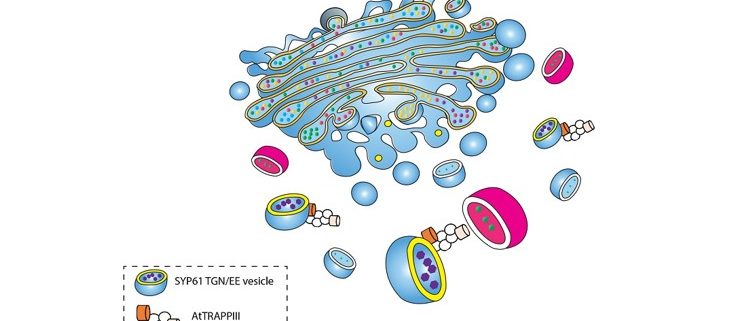TRAPP proteins as housekeepers of the plant trans-Golgi network/early endosome
Rosquete et al., identified a TRAPPIII tethering complex in plants and uncovered the role of the AtTRAPPC11 subunit in post Golgi trafficking and stress response. Plant Cell https://doi.org/10.1105/tpc.19.00110
By Michel R. Rosquete and Georgia Drakakaki
Background: Intracellular trafficking is a finely regulated process responsible for the transport of molecules between cell membrane compartments, such as the Golgi apparatus and the plasma membrane. A heterogeneous vesicle population known as the trans-Golgi network/early endosome (TGN/EE) provides an intermediate station. Vesicle fusion is required for cargo delivery between different organelles. Tethering factors are a class of proteins that facilitate vesicle fusion while also contributing to organelle organization. Many questions about their role in the maintenance of TGN/EE organization and structure remain unanswered. Transport protein particle (TRAPPs) are a type of evolutionarily conserved, multi-subunit tethering factors whose functions in the plant cell endomembrane system are poorly understood.
Question: We wanted to identify TRAPP multisubunit complexes in plants and characterize their role in endomembrane transport and plant development. By identifying similarities and differences with mammalian and yeast TRAPPs, we can better understand their role through evolution.
Findings: We showed that a previously unknown TRAPPIII complex exists in plant cells. We studied in detail one of its subunits, AtTRAPPC11, in Arabidopsis. Our study revealed that this evolutionarily conserved subunit plays a role in maintaining the organization of the TGN/EE, where it is located. In addition, it regulates endosomal trafficking. Interestingly, the mutants of this subunit are hypersensitive to salinity, indicating an undescribed role of the TRAPPIII complex in stress responses. This opens new avenues to explore the role of tethering factors in plant environmental responses.
Next steps: The function of TRAPPs relies on their ability to activate small GTPAses, which are enzymes that control intracellular trafficking. We will decipher which small GTPase(s) are targeted by the identified TRAPPIII and investigate how important these TRAPPIII-small GTPase interactions are for post-Golgi trafficking, plant development and stress response.
Michel Ruiz Rosquete, Natasha Worden, Guangxi Ren, Rosalie M. Sinclair, Sina Pfleger, Michelle Salemi, Brett S. Phinney, David Domozych, Thomas Wilkop, and Georgia Drakakaki. (2019). AtTRAPPC11/ROG2: A Role for TRAPPs in Maintenance of the Plant trans-Golgi Network/ Early Endosome Organization and Function. Plant Cell. https://doi.org/10.1105/tpc.19.00110.
Key words: TRAPP, tethering complexes, trans-Golgi Network, Early endosome, salinity, Post-Golgi trafficking, Multi-subunit complexes




